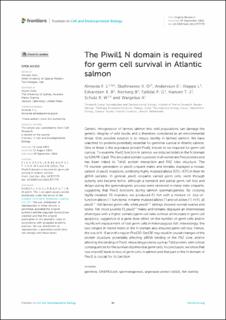| dc.contributor.author | Almeida, Fernanda Loureiro | |
| dc.contributor.author | Skaftnesmo, Kai Ove | |
| dc.contributor.author | Andersson, Eva | |
| dc.contributor.author | Kleppe, Lene | |
| dc.contributor.author | Edvardsen, Rolf Brudvik | |
| dc.contributor.author | Norberg, Birgitta | |
| dc.contributor.author | Fjelldal, Per Gunnar | |
| dc.contributor.author | Hansen, Tom Johnny | |
| dc.contributor.author | Schulz, Rüdiger W. | |
| dc.contributor.author | Wargelius, Anna | |
| dc.date.accessioned | 2022-10-31T08:42:19Z | |
| dc.date.available | 2022-10-31T08:42:19Z | |
| dc.date.created | 2022-10-20T12:48:45Z | |
| dc.date.issued | 2022 | |
| dc.identifier.citation | Frontiers in Cell and Developmental Biology. 2022, 10 . | en_US |
| dc.identifier.issn | 2296-634X | |
| dc.identifier.uri | https://hdl.handle.net/11250/3029009 | |
| dc.description.abstract | Genetic introgression of farmed salmon into wild populations can damage the genetic integrity of wild stocks and is therefore considered as an environmental threat. One possible solution is to induce sterility in farmed salmon. We have searched for proteins potentially essential for germline survival in Atlantic salmon. One of these is the argonaute protein Piwil1, known to be required for germ cell survival. To examine Piwil1 function in salmon, we induced indels in the N domain by CRISPR-Cas9. The encoded domain is present in all vertebrate Piwi proteins and has been linked to Tdrd1 protein interaction and PAZ lobe structure. The F0 founder generation of piwil1 crispant males and females displayed a mosaic pattern of piwil1 mutations, exhibiting highly mutated alleles (53%–97%) in their fin gDNA samples. In general, piwil1 crispants carried germ cells, went through puberty and became fertile, although a transient and partial germ cell loss and delays during the spermatogenic process were observed in many male crispants, suggesting that Piwil1 functions during salmon spermatogenesis. By crossing highly mutated F0 founders, we produced F1 fish with a mixture of: loss-of-function alleles (−); functional in frame mutated alleles (+) and wt alleles (+). In F1, all piwil1−/− fish lacked germ cells, while piwil1+/+ siblings showed normal ovaries and testes. Yet, most juvenile F1 piwil1+/−males and females displayed an intermediate phenotype with a higher somatic/germ cell ratio without an increase in germ cell apoptosis, suggestive of a gene dose effect on the number of germ cells and/or insufficient replacement of lost germ cells in heterozygous fish. Interestingly, the two longest in-frame indels in the N domain also ensured germ cell loss. Hence, the loss of 4–6 aa in this region Phe130-Ser136 may result in crucial changes of the protein structure, potentially affecting piRNA binding of the PAZ lobe, and/or affecting the binding of Piwil1 interacting proteins such as Tdrd protein, with critical consequences for the survival of primordial germ cells. In conclusion, we show that loss of piwil1 leads to loss of germ cells in salmon and that part of the N domain of Piwil1 is crucial for its function. | en_US |
| dc.language.iso | eng | en_US |
| dc.title | The Piwil1 N domain is required for germ cell survival in Atlantic salmon | en_US |
| dc.title.alternative | The Piwil1 N domain is required for germ cell survival in Atlantic salmon | en_US |
| dc.type | Peer reviewed | en_US |
| dc.type | Journal article | en_US |
| dc.description.version | publishedVersion | en_US |
| dc.source.pagenumber | 16 | en_US |
| dc.source.volume | 10 | en_US |
| dc.source.journal | Frontiers in Cell and Developmental Biology | en_US |
| dc.identifier.doi | 10.3389/fcell.2022.977779 | |
| dc.identifier.cristin | 2063229 | |
| dc.relation.project | Norges forskningsråd: 221648 | en_US |
| dc.relation.project | Norges forskningsråd: 267610 | en_US |
| dc.relation.project | Norges forskningsråd: 267479 | en_US |
| cristin.ispublished | true | |
| cristin.fulltext | original | |
| cristin.qualitycode | 1 | |
